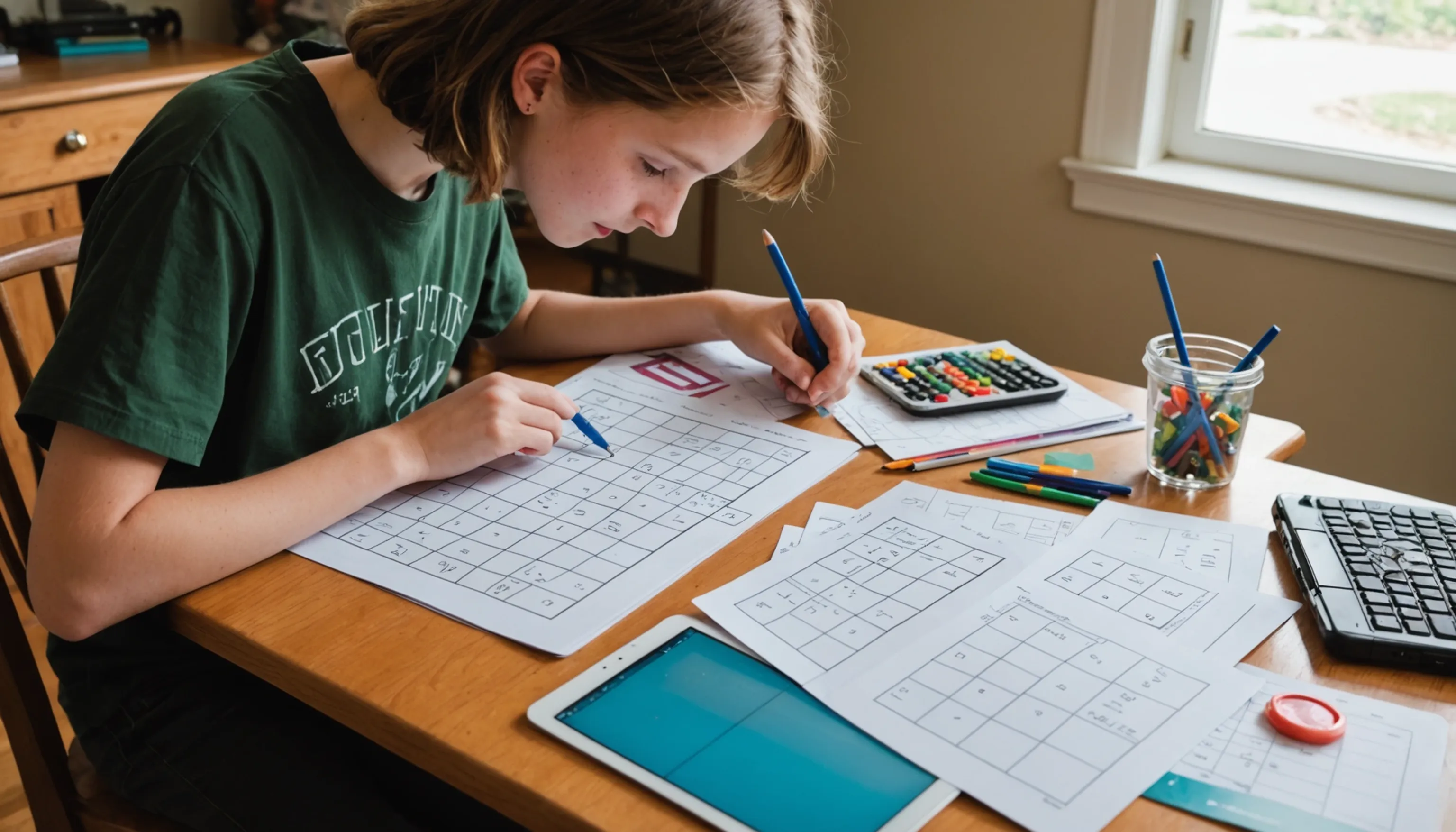How to Make Math Fun in Homeschooling
 HvWHenry van Wagenberg
HvWHenry van Wagenberg
Creative Ways to Make Math Fun in Homeschooling
Making math fun in homeschooling can significantly enhance a teenager's learning experience. One creative approach is to incorporate games that challenge their problem-solving skills while keeping them engaged. For instance, you can use board games that involve math, such as Monopoly or Math Dice, which promote numerical understanding in a playful way.
Additionally, consider integrating math into everyday activities, like budgeting for a family outing or measuring ingredients during cooking. These real-life applications not only make math relevant but also help teens appreciate its importance. Overall, a variety of creative methods can transform math into an enjoyable subject.
Incorporating Games into Math Lessons
Incorporating games into math lessons is an effective way to engage teenagers and make learning enjoyable. Games can transform abstract math concepts into tangible experiences, allowing students to grasp difficult topics with ease. Here are some ways to integrate games into your homeschooling math curriculum:
- Board Games: Use traditional board games like Monopoly or Life that require math skills for gameplay. Players must manage money, calculate expenses, or make strategic decisions based on mathematical reasoning.
- Card Games: Simple card games like Uno can be modified to practice addition or subtraction. For instance, players can add the values of the cards they play, reinforcing mental math skills.
- Online Math Games: There are numerous educational websites and apps offering interactive math games that cater to various skill levels. Websites like Khan Academy and Prodigy provide engaging platforms where teens can practice math while playing.
- Math Puzzles: Incorporate puzzles such as Sudoku or logic puzzles that challenge students to use critical thinking and mathematical reasoning. These can be both fun and educational.
By incorporating games into math lessons, parents and teachers can create a dynamic learning environment where teens can develop their math skills without the pressure of traditional studying. This approach fosters a love for math and encourages a deeper understanding of mathematical concepts.
Using Real-Life Applications for Math Concepts
Using real-life applications for math concepts can significantly enhance a teenager’s understanding and appreciation of mathematics. When students see the relevance of math in their daily lives, they are more likely to engage with the subject and retain the information. Here are several effective strategies to incorporate real-life applications into your homeschooling math lessons:
- Budgeting: Teach teens how to create a budget by tracking their income and expenses. This hands-on activity helps them apply addition, subtraction, and multiplication while managing money effectively.
- Cooking and Baking: Involve teenagers in cooking or baking, where they must measure ingredients and adjust recipes. This practical experience reinforces fractions, proportions, and conversions in a fun and tasty way.
- Shopping: Take your teen grocery shopping and discuss unit prices, discounts, and sales tax. This teaches them to compare prices and calculate savings, which are essential skills in real-world financial decisions.
- Home Improvement Projects: Engage your teen in home improvement tasks like measuring walls for painting or calculating the area of a garden bed. This not only applies geometry but also encourages critical thinking and problem-solving.
By incorporating these real-life applications, you create a learning experience that resonates with teenagers. They’ll start to recognize that math is not just a subject in school but a vital tool they use in everyday life, making the learning process more meaningful and enjoyable.

Integrating Technology in Math Learning
Integrating technology in math learning can significantly enhance the educational experience for teenagers in a homeschooling environment. With various digital tools and resources available, technology can make math more interactive, engaging, and accessible. Here are some effective ways to incorporate technology into math lessons:
- Online Learning Platforms: Websites like Khan Academy and IXL offer comprehensive math courses that adapt to individual learning paces. These platforms provide instructional videos, practice problems, and instant feedback, making math concepts easier to grasp.
- Math Apps: There are numerous apps designed for math practice, such as Photomath and GeoGebra. These apps allow students to solve problems interactively, visualize concepts, and receive step-by-step solutions, promoting independent learning.
- Virtual Manipulatives: Using virtual tools like Base Ten blocks or graphing calculators can help students visualize complex math concepts. Websites such as National Library of Virtual Manipulatives provide a variety of tools that can enhance understanding.
- Interactive Games: Incorporate math games that utilize technology, such as Prodigy or Coolmath Games. These platforms turn math practice into a fun, engaging experience that motivates students to improve their skills.
By integrating technology into math learning, parents and teachers can create a dynamic and personalized learning experience. This approach not only fosters a deeper understanding of math concepts but also prepares students for a tech-driven world.
Hands-On Activities to Enhance Math Understanding
Hands-on activities are a fantastic way to enhance math understanding for teenagers in homeschooling. These engaging approaches allow students to experience math concepts in a tactile way, making learning memorable. For example, using manipulatives like blocks or counters can help visualize addition and subtraction. Geometry can be explored by creating shapes with string or clay, reinforcing spatial awareness.
Additionally, measuring objects around the house or conducting simple science experiments can apply mathematical concepts in real-world scenarios. These hands-on experiences not only make learning enjoyable but also deepen comprehension, enabling students to grasp complex ideas more readily.
Crafting Math Projects and Models
Crafting math projects and models is an excellent way to reinforce mathematical concepts while encouraging creativity in teenagers. These hands-on activities not only make learning enjoyable but also allow students to apply their knowledge practically. Here are some engaging project ideas that can be incorporated into your homeschooling math curriculum:
- Scale Models: Have students create scale models of buildings or objects using cardboard or other materials. This project helps them understand ratios, proportions, and geometry while enhancing their spatial reasoning skills.
- Graphing Projects: Encourage teens to collect data on topics of interest, such as their favorite sports teams or weather patterns. They can then create various types of graphs, like bar graphs or pie charts, to visually represent their findings, reinforcing their understanding of data interpretation.
- Math Art: Integrate math with art by exploring concepts like symmetry and tessellations. Students can create artwork that showcases these principles, making math visually appealing.
- 3D Shapes: Challenge students to construct 3D shapes using materials like clay, straws, or toothpicks. This hands-on activity deepens their understanding of volume and surface area.
By incorporating crafting into math lessons, you create an engaging learning environment where students can explore mathematical ideas creatively. These projects not only enhance comprehension but also build critical thinking and problem-solving skills, making math relevant and enjoyable for teens.

Exploring Math through Cooking and Baking
Exploring math through cooking and baking is a delicious way to engage teenagers in mathematical concepts while enhancing their culinary skills. These activities provide a practical context for applying math, making it both enjoyable and relevant. Here’s how cooking and baking can help reinforce various math skills:
- Measurement: Cooking requires precise measurements of ingredients, which helps students practice fractions, decimals, and conversions. For example, when a recipe calls for 1/2 cup of flour, students can learn to convert it to tablespoons or compare it to other measurements.
- Ratios and Proportions: Many recipes can be adjusted to serve different numbers of people. Students can practice ratios by scaling recipes up or down, which reinforces their understanding of proportional relationships.
- Time Management: Cooking often involves multiple steps with specific timings for each process. Students can practice their time management skills by creating a timeline for meal preparation, enhancing their ability to work with elapsed time.
- Geometry: When baking, teens can learn about shapes and areas by cutting cookies or pastries into various forms. This hands-on experience brings geometry to life in a fun way.
By integrating math into cooking and baking, you create an interactive learning experience that demonstrates the practical application of math in everyday life. These activities not only make math enjoyable but also encourage critical thinking and creativity in the kitchen.
Outdoor Math Activities to Engage Teens
Outdoor math activities provide an engaging way for teenagers to explore mathematical concepts while enjoying nature. These hands-on experiences not only promote physical activity but also encourage students to see math in the world around them. Here are some creative outdoor math activities to incorporate into your homeschooling curriculum:
- Geometry Scavenger Hunt: Organize a scavenger hunt where students search for geometric shapes in their environment. They can look for triangles, circles, and squares in nature or architecture, reinforcing their understanding of shapes and spatial reasoning.
- Measurement Challenges: Take students outside to measure the perimeter and area of different outdoor spaces, such as a garden or playground. This activity helps them practice measurement skills and apply concepts of area and perimeter in real-world scenarios.
- Nature Graphing: Encourage students to collect data on natural elements, such as counting the number of different types of leaves or flowers. They can then create bar graphs or pie charts to represent their findings, reinforcing data collection and analysis skills.
- Math Relay Races: Set up a relay race where teens solve math problems at different stations. They can run to each station, complete a problem, and then race back to their team. This combines physical activity with critical thinking and problem-solving.
By incorporating outdoor math activities, you create an interactive and enjoyable learning environment. These experiences help teens appreciate the relevance of math in everyday life while promoting teamwork and collaboration.
Creating a Positive Math Environment
Creating a positive math environment is crucial for fostering a love of mathematics in teenagers during homeschooling. A supportive atmosphere encourages students to engage with math without fear of making mistakes. Here are some strategies to cultivate this environment:
- Encouragement: Celebrate small victories and progress in math, no matter how minor. Positive reinforcement boosts confidence and motivates students to tackle more challenging concepts.
- Open Communication: Foster an atmosphere where students feel comfortable asking questions and expressing difficulties. Encourage them to share their thought processes and strategies, promoting collaboration and understanding.
- Flexible Learning Spaces: Create a dedicated, organized, and inviting space for math study. A well-designed learning environment can enhance focus and productivity.
- Incorporate Variety: Use diverse teaching methods, including games, technology, and hands-on activities, to make math more engaging and enjoyable.
By focusing on these aspects, you can help teenagers develop a positive relationship with math, leading to greater success and enjoyment in the subject.
Encouraging a Growth Mindset in Math
Encouraging a growth mindset in math is essential for helping teenagers develop resilience and a positive attitude toward learning. A growth mindset is the belief that abilities can be developed through dedication and hard work, which is particularly important in a subject like math that many find challenging. Here are several strategies to promote this mindset:
- Emphasize Effort Over Perfection: Reinforce the idea that making mistakes is a natural part of the learning process. Encourage students to focus on their effort and improvement rather than solely on correct answers.
- Set Realistic Challenges: Provide math problems that are appropriately challenging. This encourages students to stretch their abilities without feeling overwhelmed. Gradually increase the difficulty as they gain confidence.
- Model a Growth Mindset: Share your own experiences with challenges and how you overcame them. Discuss the importance of persistence and learning from failures, showing that growth comes from facing difficulties head-on.
- Encourage Reflection: After completing math tasks, have students reflect on what they learned, what strategies worked, and what they could improve next time. This fosters self-awareness and promotes continuous growth.
By instilling a growth mindset, you help teenagers view math as a subject that they can improve in with practice and effort. This approach not only enhances their mathematical skills but also builds resilience and confidence in their abilities.
Setting Realistic Goals and Celebrating Achievements
Setting realistic goals and celebrating achievements in math is vital for maintaining motivation and building confidence among teenagers in a homeschooling environment. By establishing clear, attainable objectives, students can focus their efforts and track their progress effectively. Here are some strategies for setting goals and celebrating success:
- SMART Goals: Encourage students to set SMART goals—Specific, Measurable, Achievable, Relevant, and Time-bound. For example, instead of saying, "I want to get better at math," a SMART goal would be, "I will complete five math practice problems every day for two weeks." This clarity helps them understand what they need to accomplish.
- Break Down Larger Goals: For more complex topics, break down larger goals into smaller, manageable tasks. This approach helps reduce overwhelm and allows students to experience success along the way.
- Track Progress: Use a visual tracker, like a chart or journal, to document achievements. This can boost motivation as students see their progress over time.
- Celebrate Milestones: Celebrate when students reach their goals, whether through verbal praise, small rewards, or fun activities. Recognizing their accomplishments reinforces positive behavior and encourages further effort.
By setting realistic goals and celebrating achievements, you help teenagers build a positive relationship with math, fostering a sense of accomplishment that motivates them to continue learning and growing in the subject.
